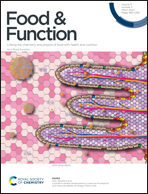 “Over the last two decades, affirmative diagnoses of osteoarthritis in the United States have tripled due to increasing rates of obesity and an aging population.
“Over the last two decades, affirmative diagnoses of osteoarthritis in the United States have tripled due to increasing rates of obesity and an aging population.
Hemp-derived cannabidiol (CBD) is the major non-THC component of cannabis and has been promoted as a potential treatment for a wide variety of disparate inflammatory conditions.
Here we evaluated CBD for its ability to modulate the production of pro-inflammatory cytokines in vitro and in murine models of induced inflammation and further validated the ability of a liposomal formulation to increase bioavailability in mice and in humans.
Subsequently, the therapeutic potential of both naked and liposomally-encapsulated CBD was explored in a 4-week, randomized placebo-controlled, double-blinded study in a spontaneous canine model of osteoarthritis.
In vitro and in mouse models, CBD significantly attenuated the production of pro-inflammatory cytokines IL-6 and TNF-α while elevating levels of anti-inflammatory IL-10. In the veterinary study, CBD significantly decreased pain and increased mobility in a dose-dependent fashion among animals with an affirmative diagnosis of osteoarthritis.
Liposomal CBD (20 mg/day) was as effective as the highest dose of non-liposomal CBD (50 mg/day) in improving clinical outcomes. Hematocrit, comprehensive metabolic profile, and clinical chemistry indicated no significant detrimental impact of CBD administration over the four-week analysis period.
This study supports the safety and therapeutic potential of hemp-derived CBD for relieving arthritic pain and suggests follow-up investigations in humans is warranted.”

 “Cannabis has been used to relieve the symptoms of disease for thousands of years. However, social and political biases have limited effective interrogation of the potential benefits of cannabis and polarised public opinion.
“Cannabis has been used to relieve the symptoms of disease for thousands of years. However, social and political biases have limited effective interrogation of the potential benefits of cannabis and polarised public opinion. “The approval of 9-δ-tetrahydocannabinol (THC)+
“The approval of 9-δ-tetrahydocannabinol (THC)+ “The growing concern on the antibiotic resistance spreading among bacteria has stimulated the search for valuable alternatives from plant sources.
“The growing concern on the antibiotic resistance spreading among bacteria has stimulated the search for valuable alternatives from plant sources.
 “Inflammatory bowel diseases (IBD) are characterized by a chronic and recurrent gastrointestinal condition, including mainly ulcerative colitis (UC) and Crohn’s disease (CD). Cannabis sativa (CS) is widely used for medicinal, recreational, and religious purposes. The most studied compound of CS is tetrahydrocannabinol (THC) and
“Inflammatory bowel diseases (IBD) are characterized by a chronic and recurrent gastrointestinal condition, including mainly ulcerative colitis (UC) and Crohn’s disease (CD). Cannabis sativa (CS) is widely used for medicinal, recreational, and religious purposes. The most studied compound of CS is tetrahydrocannabinol (THC) and  “Hempseed (Cannabis sativa L.) has beneficial impact on human health mainly because of its wide variability of bioactive compounds. However, many of them are not fully characterized yet. In this work, hempseed was defatted and through a bio-guided studied, two fractions (F03 and F05) with the highest content of phenols, flavonoids and antioxidant capacity were selected. Fractions were chemically analyzed by UHPLC HRMS/MS. The anti-inflammatory capacities of these compounds were evaluated on human monocytes using flow cytometry, RT-qPCR and Elisa procedures. A high amount of phenolic compounds were identified, with the major compound being: N-trans-caffeoyltyramine (6.36 mg g-1 in F05 and 1.28 mg g-1 in F03). Both, F03 and F05 significantly reduced the inflammatory competence of LPS-treated human primary monocytes, decreasing TNF-α and IL-6 gene expression and secretion. These findings indicate that in the defatted fraction of the hempseed there are a wide number of compounds with beneficial potential to prevent and treat inflammatory disorders, as well as other processes caused by oxidative stress.”
“Hempseed (Cannabis sativa L.) has beneficial impact on human health mainly because of its wide variability of bioactive compounds. However, many of them are not fully characterized yet. In this work, hempseed was defatted and through a bio-guided studied, two fractions (F03 and F05) with the highest content of phenols, flavonoids and antioxidant capacity were selected. Fractions were chemically analyzed by UHPLC HRMS/MS. The anti-inflammatory capacities of these compounds were evaluated on human monocytes using flow cytometry, RT-qPCR and Elisa procedures. A high amount of phenolic compounds were identified, with the major compound being: N-trans-caffeoyltyramine (6.36 mg g-1 in F05 and 1.28 mg g-1 in F03). Both, F03 and F05 significantly reduced the inflammatory competence of LPS-treated human primary monocytes, decreasing TNF-α and IL-6 gene expression and secretion. These findings indicate that in the defatted fraction of the hempseed there are a wide number of compounds with beneficial potential to prevent and treat inflammatory disorders, as well as other processes caused by oxidative stress.” “Hemp (Cannabis sativa L.) has become widely used in several sectors due to the presence of various bioactive compounds such as terpenes and
“Hemp (Cannabis sativa L.) has become widely used in several sectors due to the presence of various bioactive compounds such as terpenes and  “Cannabis use in the management of musculoskeletal diseases has gained advocacy since several states have legalized its recreational use.
“Cannabis use in the management of musculoskeletal diseases has gained advocacy since several states have legalized its recreational use.
 “This preliminary study examines whether daily CBD dose of 15-25 mg/kg produces cerebral macrostructure changes and, if present, how they relate to changes in seizure frequency.
“This preliminary study examines whether daily CBD dose of 15-25 mg/kg produces cerebral macrostructure changes and, if present, how they relate to changes in seizure frequency.